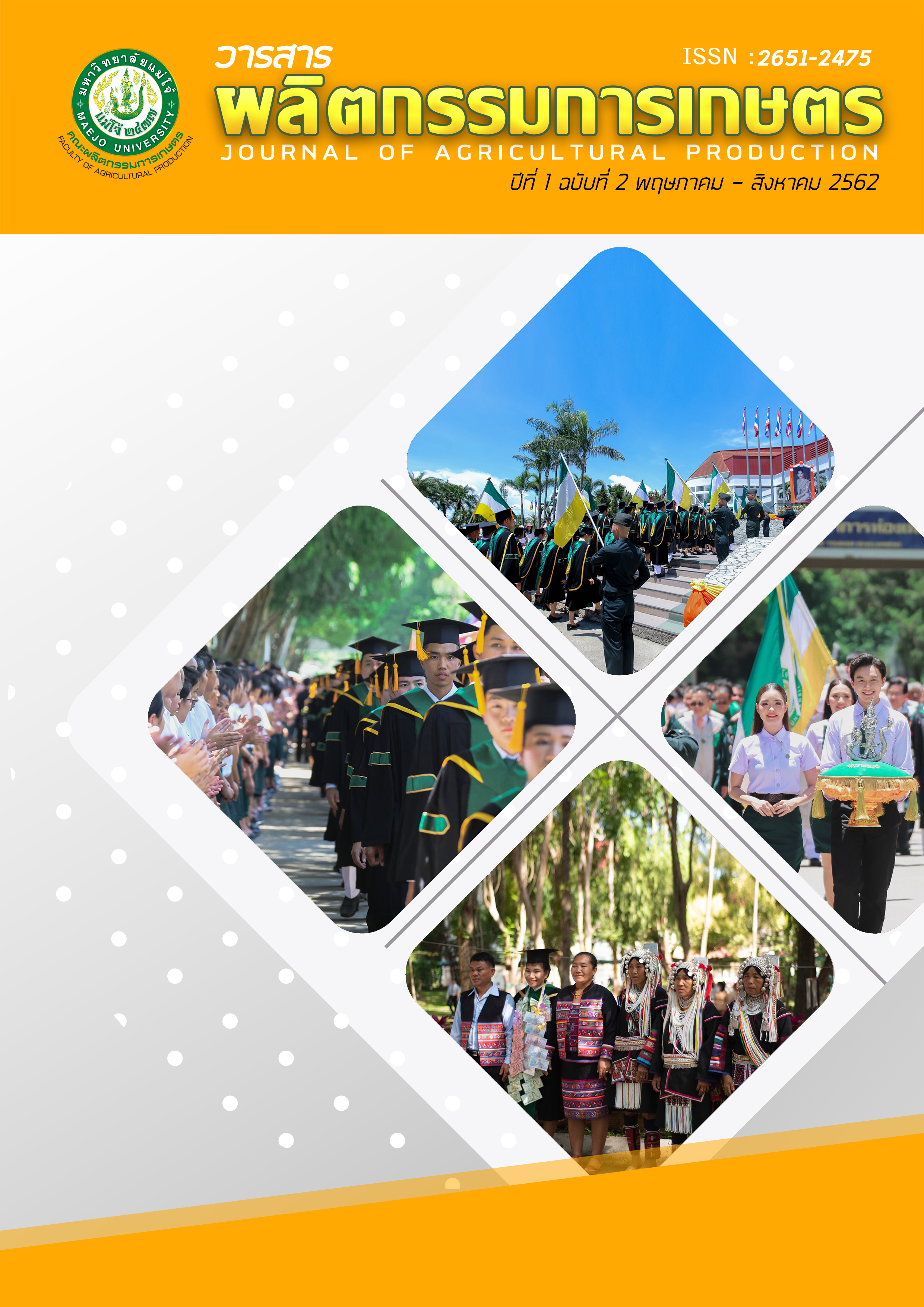Selection of Potato Trial Varieties in Northern Thailand
Main Article Content
บทคัดย่อ
The selection of potato trial varieties in Northern Thailand was conducted at Chiang Mai Agricultural Research and Development Center (CMARDC), Chiang Rai Horticultural Research Center (CRHRC) and Tak Agricultural Research and Development Center (TARDC) in 2017 - 2018. All experiments were laid out using a randomized completely block design RCBD with 3 replications and 9 treatments (YS 202, 203, 301, 304, 401, 506, 603 and Atlantic and Spunta). Variables reflecting the performance, quality and resistance to disease were recorded. Findings show that YS203 at CMARDC, CRHRC and TARDC yielded a greater number of tubers per plant (15, 14 and 10 tubers per plants, respectively), tuber weight per plant (688, 362.7, 268.7 g, respectively), and total yield (5,198, 2,739 and 2,030 kg/rai, respectively) than Spunta and other varieties but lower than Atlantic at CMARDC and TARDC. In terms of quality attributes, total solid content of YS202 at CMARDC, CRHRC and TARDC was 22.7, 21.2, 18.6 %, respectively. However, YS203 at TARDC and CRHRC was found to be consistently firmer (0.87, 0.85 N, respectively) than those of Spunta and other varieties. Findings also showed that total tuber weights per plant were positively correlated with total solid and total solution solid content. Overall the findings suggest that out of all of the varieties grown included in the trials, varieties YS203 and YS202 were the best for processing. Further investigation on the selection of potato trial varieties for late blight resistance, nutritional quality, satisfaction of farmers and consumers, and marketing acceptance should be conducted in the future.
Article Details

อนุญาตภายใต้เงื่อนไข Creative Commons Attribution-NonCommercial-NoDerivatives 4.0 International License.
เอกสารอ้างอิง
Bhat, R. 2015. Varying amylose and total starch content in potato tubers derived from Finland and Sweden. M.S. Thesis in Department of Food Science, Faculty of Natural Resources and Agricultural Sciences, Swedish University of Agricultural Sciences.
Feltran, J.C., L.B. Demos and R.L. Vieites. 2004. Technological quality and utilization of potato tubers. Sci. Agr. (Piracicaba, Brazil) 61: 598-603.
Kays, S.J. 1991. Postharvest physiology of perishable plant products. Van Nostrand Reinhold Inc. NY, USA.
Kittipadakul, P., B. Jaipeng, A. Slater, W. Stevenson and S. Jansky. 2016. Potato production in Thailand. Am. J. Potato Res. 93(4): 380-385.
Molders K., M. Quinet, J. Decat, B. Secco, E. Dulie`re, S. Pieters, T. Van Der Kooij, S. Lutts, and D. Van Der Straeten. 2012. Selection and hydroponic growth of potato cultivars for bioregenerative life support systems. Adv. Space Res. 50: 156-165.
Murphy, H.J. and M.J. Goven. 1959. Factors affecting the specific gravity of the white potato in Maine. Maine Agr. Exp. Sta. Bul. 583.
Office of agricultural economics. 2016. Agricultural economic report 2016. Agricultural statistics. Ministry of agriculture and cooperatives 402: 68-69. (In Thai)
Singh, J. and L. Kaur. 2009. Advances in potato chemistry and technology. Academic Press, Elsevier, NY, USA.
Vakis, N.J. 1978. Specific gravity, dry matter content and starch content of 50 potato cultivars grown Dunder Cyprus conditions. Potato Res. 21: 171-181.
Wongmetha O. 2017. Annual report on technology dissemination of virus-free seed potato production using hydroponic production systems in Thailand. pp. 147-177. In: Y. Jin, (Ed.), 2017 AFACI Program Workshop on Seed Potato Production. Asian Food and Agriculture Cooperation initiative (AFACI), Rural Development Administration (RDA) and Indonesian Agency for Agricultural Research and Development Ministry of Agriculture.


